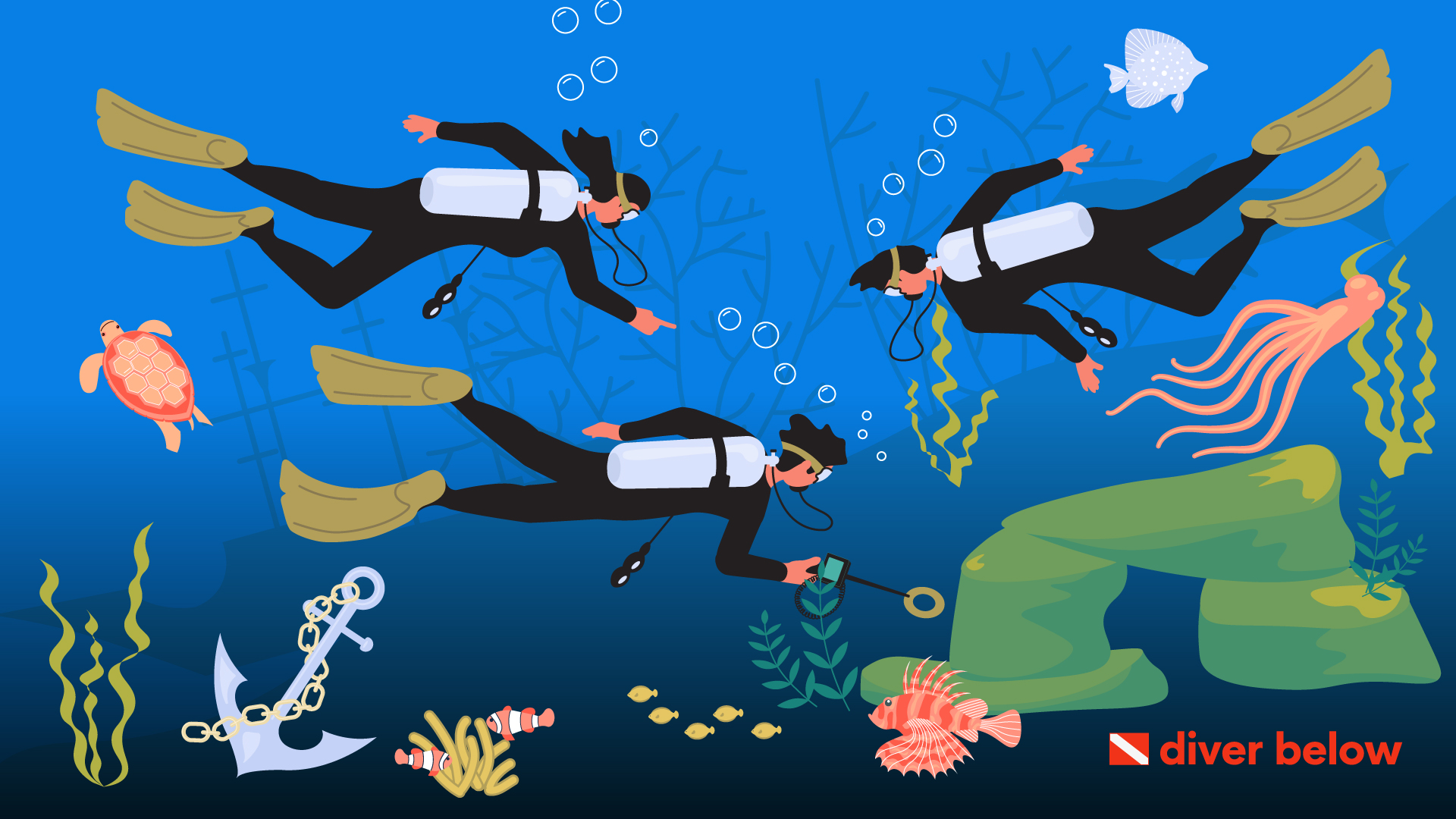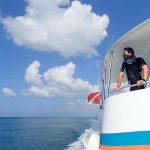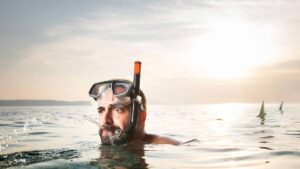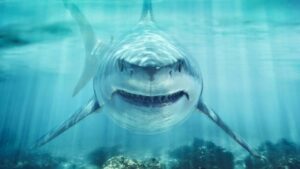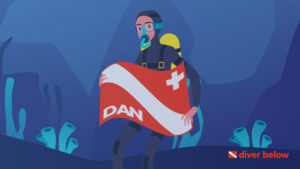For centuries we have been learning new and innovative ways to explore the world around us.
One of the most challenging environments to observe has been the ocean.
Since we humans don’t have the capability of breathing underwater, certain mysteries still elude us, and there is much to discover still.
Thankfully, brilliant minds of the past created scuba equipment to allow people to venture into the unknown.
For those that are new to scuba diving and want to learn the basics, you’ve come to the right place.
We’ll delve into the history of the sport, the necessary credentials to become certified, and frequently asked questions.
Let’s dive in! (No pun intended)
Contents
What Is Scuba Diving?
Scuba diving refers to an underwater swimming activity that requires the diver to use a breathing apparatus while they are submerged.
This equipment houses a separate air supply than that which is above the surface.
Scuba Acronym: What Does Scuba Stand For?
S.C.U.B.A. is an acronym that means “Self-Contained Underwater Breathing Apparatus.”
The gear consists of a metal tank that contains compressed air or nitrox, which is a mixture of breathing gases.
Attached to the tanks is a regulator that reduces the air pressure in the tank to make the air breathable.
A thin hose transports this air directly into the diver’s mouth.
As the diver breathes out, the air gets released into the surrounding water making tiny bubbles.
Brief Overview of Scuba Diving
You have to train to master the skill before you can truly enjoy it.
You would usually begin learning in confined waters before you can progress to diving in the open sea.
You can participate in diving as a professional or for recreational purposes.
Some fields where it’s useful are in the military, scientific occupations like marine biologists, and public safety jobs.
When possible, commercial scuba divers use diving equipment that functions with air supplied from the surface.
Divers have to get trained in the necessary skills and procedures dictated by the certification they pursue.
They get assessed by certified diving instructors affiliated with a recognized diving association.
Scuba divers should be knowledgeable about standard underwater hazards, how to help themselves in emergencies, and other strategies to address common scuba diving problems.
To become certified, the individual should possess a basic level of health and fitness.
Some roles require high levels of fitness, such as a military professional.
Even if a diver doesn’t want to get certified, these skills are still beneficial to avoid injuries or complications while in the water.
From a safety perspective, anyone interested in scuba diving should take training courses to better understand the environment and certain techniques.
PADI, the largest diving association in the world, sustains high standards of service and training for the proper facilitation of diving for its members.
A Brief History of Scuba
Scuba diving is an interesting sport that originated in ancient times.
Greeks and Romans would often hold their breath while diving or swimming undersea, and they sometimes used hollow plant stems as impromptu breathing apparatuses.
This strategy was useful when collecting materials and food from the ocean, and even during combat.
The problem with doing it this way is that you could only go beneath the surface about two or three feet because of the ambient pressure.
Not too long after this obstacle presented itself, diving bells arrived to help divers stay immersed for a longer period.
They were also able to go to a deeper depth while underwater.
Innovators in England and France constructed leather diving suits that gave divers the ability to go as far as 60 feet below the surface.
Air reached the suits from manual pumps above the water.
Inventors continually made improvements to these suits that went from leather to metal, durable enough to handle more challenging operations.
Fast-forward to today and nearly six million people worldwide are certified scuba divers.
Millions more participate recreationally as a hobby or for health benefits.
Scuba equipment continues to get lighter, less expensive, and more advanced each year.
Who Invented Scuba?
The acronym came by way of Dr. Christian Lambersten around 1954.
He has created an invention called the Lambertsen Amphibious Respiratory Unit, or LARU, and SCUBA was its new name.
Who Invented Scuba Gear?
The first sets of scuba gear that had commercial success were from Jacques-Yves Cousteau and Emile Gagnan.
In 1943, they created the Aqualung dual hose open-circuit units.
The cylinders with compressed air mounted on the diver’s back would carry compressed air through the demand regulator for inhalation.
The diver exhaled the air into the surrounding water next to the tank.
Types of Scuba Diving
Today, we enjoy multiple types of scuba diving.
Below is a brief breakdown of each form.
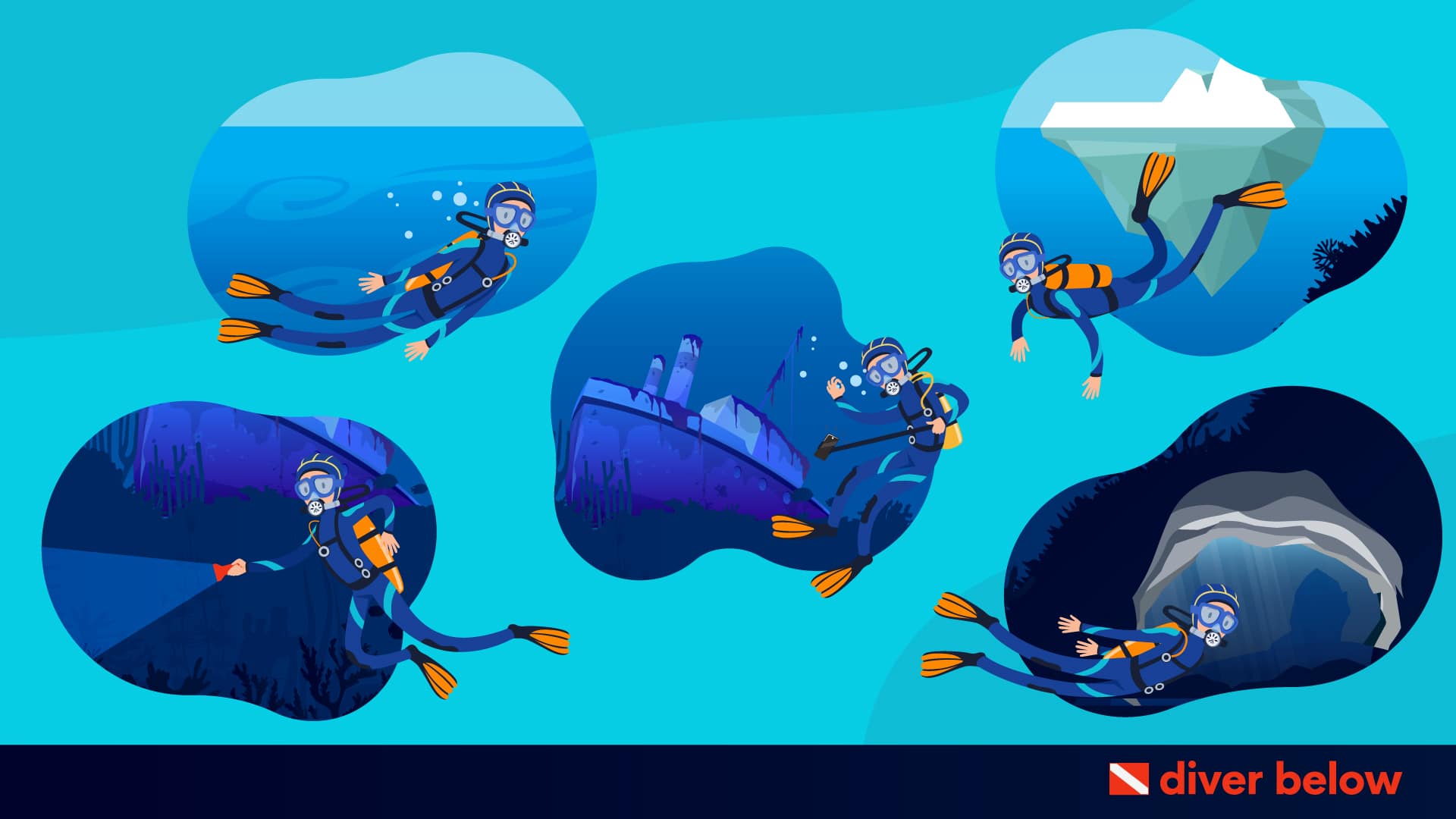
Recreational Diving
Recreational diving means that you’re diving for leisurely purposes.
The risks of diving get reduced by participating in the training of standard procedures and skills that match the chosen equipment and environment where the diver wants to dive.
Recreational divers don’t usually go deeper than 130 feet underwater.
The open-circuit scuba equipment is the preferred gear of recreational divers.
Continued training and practice allow scuba divers to dive safely and expand their options for where and how they scuba dive.
There is also special training available to recreational divers.
Technical Diving
The lines sometimes get blurred between a recreational diver and a technical diver.
Tech diving is a form of scuba diving that goes beyond the limits set by PADI (and other agencies) for non-professional reasons.
Divers risk exposure to heightened dangers when compared to the standard threats linked to recreational diving.
Consequently, there’s a higher chance of serious injuries or death.
Some of these risks can be accounted for by specialty training and more advanced equipment.
The required equipment usually includes breathing gases instead of standard nitric mixtures or air.
Technical divers can go as deep as 170 feet to 350 feet, and sometimes even further depths.
Rescue Diving
A rescue diver has received a certification from a scuba diving training agency (SDI, PADI, NAUI, SSI) to address emergency response situations.
The certified scuba diver can rescue other divers, and their training has informed them on tasks such as bringing a non-responsive diver to the surface; this is probably the most difficult skill to learn.
They have to bring them up while simultaneously detaching equipment and providing rescue breaths.
In addition to completing the necessary training, a scuba diver must have valid CPR and first aid training for certification.
Variations of Scuba Diving
There is another variation of scuba diving that carries less risk, known as SNUBA diving.
Learn the type of equipment, training, and abilities that you need to snuba dive to determine if it’s an alternative that you’d like to explore.
Snuba
Snuba is a way to swim and explore undersea with a surface-supplied air supply.
Snuba International developed this breathing system as a cross between “snorkeling” and “scuba.”
The main difference between scuba diving and snuba diving is that scuba diving requires scuba certification and heavier equipment.
Also, you can go to deeper depths when you’re a certified scuba diver; SNUBA has a limit of 20 feet.
Instead of the air tank that you usually wear on your back, the air tank sits atop a raft; it goes where and as you go!
This air tank gets connected to an airline that is also connected to your harness.
The equipment that you’ll wear:
- Fins
- Regulator
- Mask
- Harness
- Weighted belt (dive weights)
This is the perfect substitute for scuba diving because you don’t have to go through extensive training to enjoy snuba diving.
It’s an activity that the entire family can enjoy relatively quickly.
Who Can Scuba Dive?
Though scuba diving is open to anyone to learn, there are certain prerequisites that you must follow.
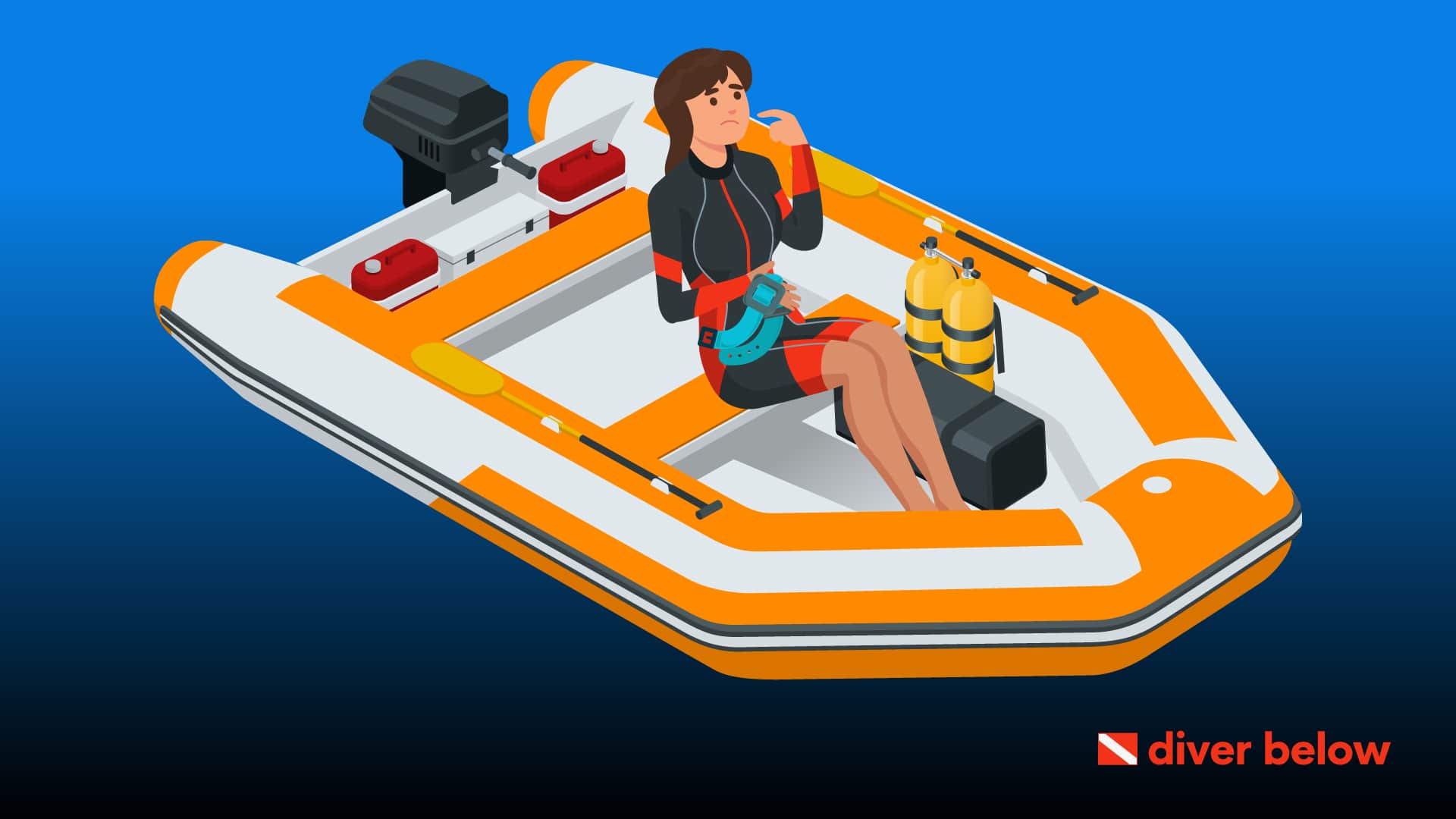
Qualifications for Scuba Diving
To receive the green light to go scuba diving, you have to be at least ten years old.
Otherwise you won’t be able to enroll in scuba diving courses.
Some programs offer training for children that are eight or nine, in shallow, controlled waters.
In the United States, most organizations require a child to be 12 years old before they are eligible to receive certification to go scuba diving.
Aside from this, the candidate has to have good physical health, a spirit for adventure, be mentally and emotionally mature enough, and also possess adequate swimming skills.
While you don’t have to be a great swimmer, you have to be comfortable in the water, able to float for at least ten minutes, and swim around 200 meters (656 feet) if possible.
Which Notable Celebrities Scuba Dive?
Many celebrities also like to enjoy the water sport for the occasional dip when they’re not busy wowing us in Hollywood.
Some of the following celebrities have been diving since young ages, and others joined in as adults.
Take a look at a few stars that like to explore the deep blue sea:
- Salma Hayek
- Jessica Alba
- Tiger Woods
- Steven Tyler
- Tom Hanks
- Tom Cruise
- The British Royal Family
- Patrick Stewart
- William Shatner
- John Krasinski
- Sandra Bullock
- Paris Hilton
- Ryan Reynolds
- Blake Lively
- Al Gore
- Glenn Close
- Jeff Gordon
- Samuel L. Jackson
Why Is Scuba Diving Fun?
Scuba diving is fun for various reasons.
Some people truly enjoy being able to be carefree while roaming around the open waters.
The ocean is a magnificent space with fascinating wildlife and biodiversity.
Scuba diving gives divers the ability to swim beside sea turtles, get up close and personal with coral reefs, and investigate the underwater playground.
With the proper equipment and certification, qualified individuals can start scuba diving for leisure while also enjoying multiple health benefits like increased muscle strength and aerobic activity, and decreased stress levels.
Gear Needed for Scuba Diving
You’ll need to assess your dive equipment needs to ensure that you’re safely venturing underwater.
Here’s a list of the scuba gear that you’ll need and how it functions.
You might also be interested in other add-on accessories not mentioned, like a safety sausage, dive reels, or even signaling devices.

BCD
A BCD, or a buoyancy compensation device, allows the scuba diver the ability to control their buoyancy levels while diving.
The buoyancy control device is connected to an inflatable air bladder, which inflates and deflates at the diver’s command, as necessary.
If they add air to the bladder, the diver is more buoyant.
If they consistently release air, they’ll be less buoyant.
This function means the diver can sink or rise in water as they please.
The air gets added through the air-inflation valve.
The BCD also holds dive weights that are sometimes necessary to sink.
These are helpful when diving with a thick exposure suit or during times when you find it hard to sink.
Mask
A scuba mask makes you more comfortable while you’re under the water.
It creates a pocket of air around your eyes and your nose.
The primary purpose is to allow you to see better, which is essential for more than just exploration.
Being able to see is also useful for reading someone’s hand signals and checking the pressure gauges.
Additionally, the best scuba masks are made from sturdy materials, like silicone and tempered glass, to withstand the pressure of the descent and ascent into the ocean.
Aside from keeping the water out of your nose, the scuba mask helps your lungs to function better as it pertains to pressurization.
The air pocket that’s in your mask could cause suction problems as you go down into the water if the mask isn’t covering your nose.
Regulator
The scuba regulator is the part of the gear that carries air to the diver’s mouth so that they can breathe freely undersea.
This occurs in two distinct stages to reduce the high air pressure from the scuba tank.
These two stages work in unison to deliver air at a comfortable pressure for the diver.
Your typical regulator has a single-hose design.
The hose moves air from the tank via the first stage that’s attached to the air tank, and then the second stage goes through the mouthpiece for easy breathing.
Fins
Dive fins make it much easier to move throughout the water while swimming.
They are the more effective and efficient method of foot-propulsion.
Dive fins come up against resistance when you move them back and forth, just like you feel on your bare feet.
But because fins have a larger surface area, they work better, especially for scuba diving.
This large space helps to displace the water backward, thereby creating a forward-thrusting moment.
SPG or Dive Computer
The submersible pressure gauge (SPG), or the dive computer, is a device that gives the diver the latest information to ensure safe diving.
It reads the time and depth information and correlates it to the decompression model that tracks how much nitrogen is dissolved in the body during the dive.
The dive computer will inform you of how much safe dive time remains.
Additional information displayed on the SPG:
- Emergency decompression
- Diving depth
- Low battery warning
- Time
- Ascent rate
- Enriched air compatible
- Previous diving information
- No-stop limits
- How much no stop time remains
Read more about the best dive computers to keep you safe during a dive.
Exposure Protection
Scuba divers can comfortably swim in various water temperatures if they wear exposure protection such as a wetsuit, drysuit, or rash guard.
A wetsuit works because it offers thermal protection while swimming in cold water.
It traps a layer of water between the fabric of the suit and your body.
Your body then produces heat that warms the water and thus your body.
A wetsuit or skinsuit that has 1–3 mm of thickness is ideal for warm waters, and the legs and arms are left open.
A thicker dive skin that covers the whole body, with a thickness of 5–7 mm, and a hood plus gloves, is better for cold waters.
A drysuit doesn’t allow any water in at all; the diver stays warm based on how many layers of undergarments they wear.
Exposure protection is also important because it keeps divers away from scratches and stings.
Booties
Scuba diving booties cover the diver’s foot and provide insulation; they can be thick or thin.
Think of diving booties as a cross between boots and socks.
The sole is usually a hard bottom, and the top half is a softer neoprene material.
Dive booties also provide comfort while swimming and protection from injuries such as abrasions.
Ideally, divers should wear booties with open-heel fins.
These fins have adjustable straps on the heel to keep the fin in place.
There’s no need for booties with closed-heel fins.
Mesh Bag
A mesh bag is an optional add-on used to carry all of your scuba equipment.
Small mesh bags are good for carrying small accessories like fins and your mask onto the boat.
Larger mesh bags are best if you want to carry all of your scuba gear at once.
The most significant benefit of mesh bags is that the water can drain out, allowing air to circulate, facilitating faster drying.
Scuba Diving Certifications
It is best to take a scuba certification course if you want to scuba dive, simply because there’s a certain level of knowledge and skill that reduces your risk of injury.
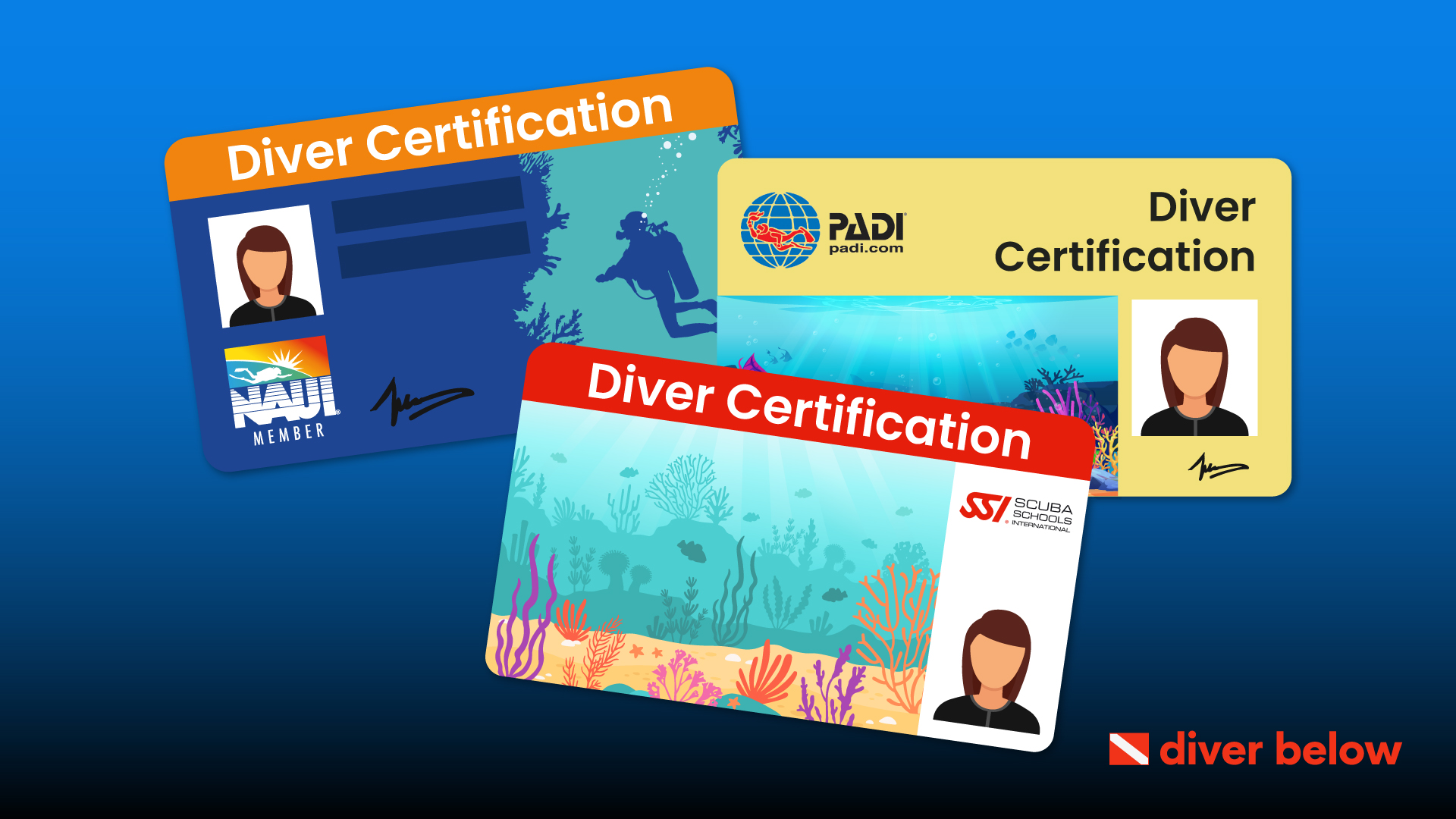
Certification Agencies
Below are the different agencies that offer certification.
SSI
Scuba Schools International is a scuba diving organization that assists free divers and scuba divers with pertinent skills.
SSI also supports numerous resorts and dive businesses, and they have multiple offices worldwide.
Through online learning courses, as well as open and confined dives, the agency builds confidence.
If you receive an SSI certification, you will learn how to dive in open waters up to 12 meters with an instructor.
Your certification will not expire if you have completed the requirements.
However, if you remain inactive for two years, you will have to renew the certification and possibly participate in more programs.
PADI
The Professional Association of Diving Instructors, or PADI for short, is the leading organization for scuba diver training worldwide.
Their learning system is built upon a gradual training structure that establishes safety-related knowledge, skills, and mastery of the local environment in stages for their students.
One of the biggest advantages of training with PADI is that they offer realistic and practical scenarios to gain the best experience as a diver.
Safety is at the forefront of each lesson, and the agency’s focus centers on four components: education, experience, equipment, and environmental conservation.
NAUI
The National Association of Underwater Instructors, also known as NAUI Worldwide, is one of the most reputable scuba diving agencies in the world.
This non-profit training organization offers trainees educational resources for every level of diving.
NAUI’s standard of excellence has provided guidance for many notable associations such as the United States Navy SEALS.
NAUI diver safety programs and learning resources display the agency’s high leadership skills in recreational and technical diving.
A NAUI certification trains divers to develop, organize, plan, and lead independent dives.
Which Certification Agency Is the Best?
While each of the organizations is suitable for learning the proper skills and knowledge to scuba dive, PADI is by far the world’s leader for certifications.
Common Certification Levels
There are several common certifications provided by scuba diving agencies, but what do they enable a diver to do?
Let’s take a look at the most common recreational and professional certification levels available around the world.

Recreational Diver Certifications
Recreational diving has three popular certification levels for divers:
1. Open Water Diver
An OWD certification is the first level.
An expert instructor teaches the diver to scuba dive in a calm and reassuring environment.
You’ll learn the basic scuba skills of breathing, assembling equipment, facing adversity underwater, and more in the open water course.
2. Advanced Open Water Diver
The AOWD level course hinges on progression and refining basic skills previously learned.
Divers take on buoyancy and navigation, diving in deep waters, and learning specialty dives.
Divers can earn specialty credits (depending on the selected training agency) toward other certifications including, but not limited to:
- Diving Against Debris
- Digital Underwater Imaging
- Wreck Diving
- Night diving
- Search and Rescue
3. Master Diver
The Master Diver certification is for elite divers that have put in the hard work necessary to achieve this rating.
They must also have had at least 59 logged dives and notable experience and training as a diver.
Aspiring Master Divers also have to get trained in five special dives.
4. Professional Diver Certifications
Profession Diver Certifications are available for those divers that have a passion for teaching others about aquatic exploration.
5. Dive Master
Dive Master certification lets the diver oversee and assist with scuba diving activities and lessons.
Learn how to become an effective leader by working on your water skills, hands-on assessments, and development workshops.
Covered topics include dive setup and management, diver safety and risk management, mapping an open western environment, and more.
6. Assistant Instructor
If a Master Diver has gained six months of experience, they can apply to get certified as an Assistant Instructor (AI).
You need 60 logged dives in addition to 100 regular dives to take the Instructor Examination.
All First Aid and CPR training must be recent to qualify for Assistant Instructor certification.
Teaching other divers how to be safe and enjoy the water is one of the nurse-rewarding aspects of this certification.
7. Open Water Scuba Instructor
The OWSI certification is similar to the Assistant Instructor in terms of requirements.
You must have completed your time and role as an AI before you can apply to become an Open Water Scuba Instructor.
You must have at least 60 logged dives and 100 or more general dives.
Less than two percent of divers achieve this level of certification, making it a unique and special group.
Where to Scuba Dive
Where a diver chooses to scuba dive largely depends on their skill level and amount of experience in the water.
Additionally, where they live may also be a factor.
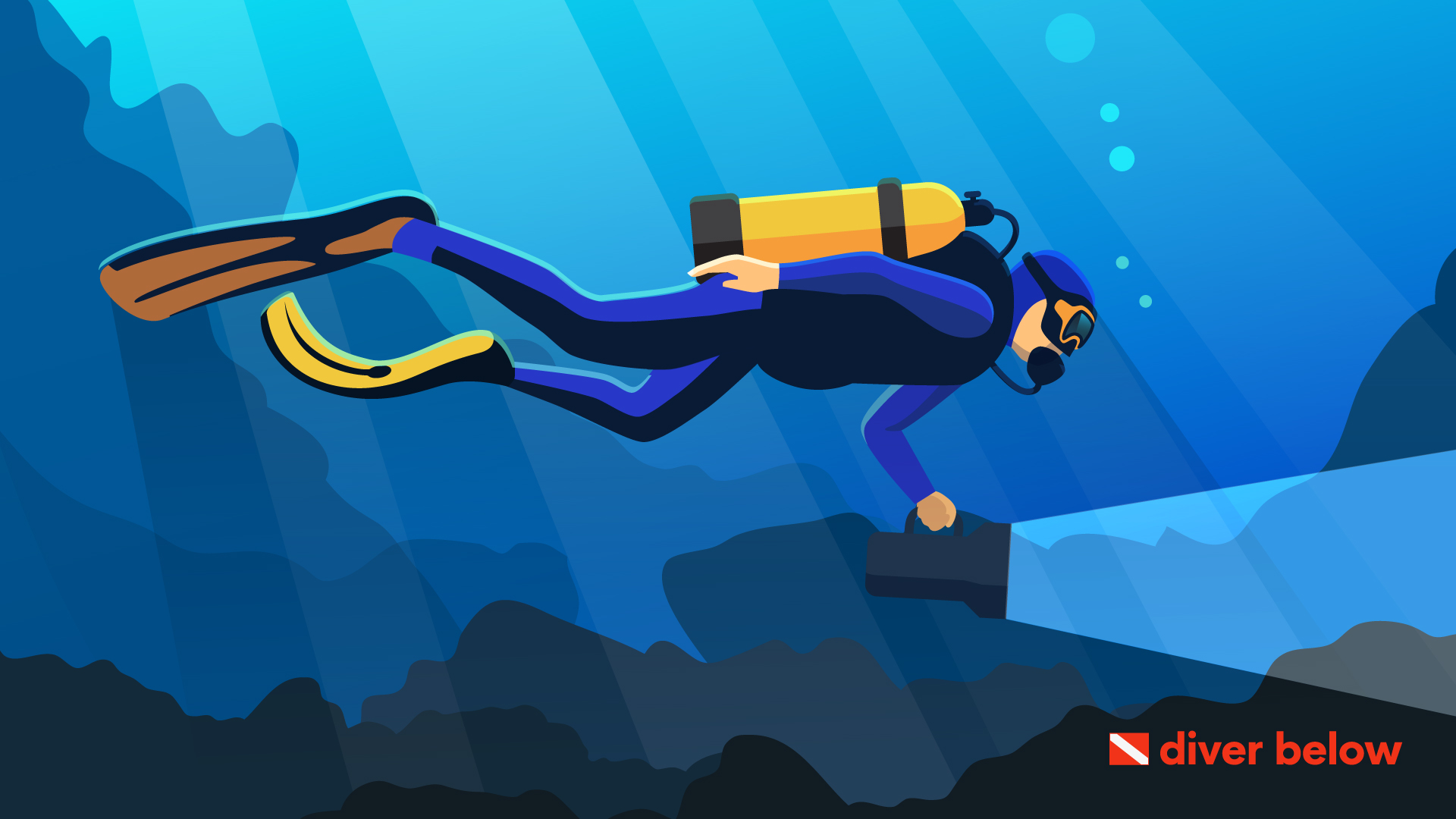
Pools (Best for Learning)
Pools are an excellent environment to learn how to scuba dive.
It feels more secure, and the reassurance allows divers to get comfortable with the water and basic equipment.
The diver will usually practice with depths of around three meters, and they’ll learn breathing exercises and how to properly ascend and descend into the water.
Additionally, divers can practice any time of year.
Lakes & Quarries (Best for Landlocked People)
If divers don’t live near an ocean, a lake is a suitable alternative for diving.
The water visibility won’t be as clear, and the water is a little colder, but there are some advantages.
The water will be shallower and calmer, and there will be fewer challenges like rip tides, undertows, or dangerous sea life.
You also wouldn’t have to deal with salt water, which can be corrosive to metal scuba equipment.
Oceans & Beaches ( Best Scenery)
If you are a diver that has the opportunity to venture into the ocean, absolutely go for it.
The water visibility is second to none, as well as the overall experience.
There are so many species of fish and plants in the ocean; that can’t get duplicated in a pool or lake.
For clear blue waters and an incredible adrenaline pump, take a dive in the ocean for the best experience of scuba diving.
Best Places To Scuba Dive
There are several beautiful destinations around the world, perfect for scuba diving professionally or recreationally.
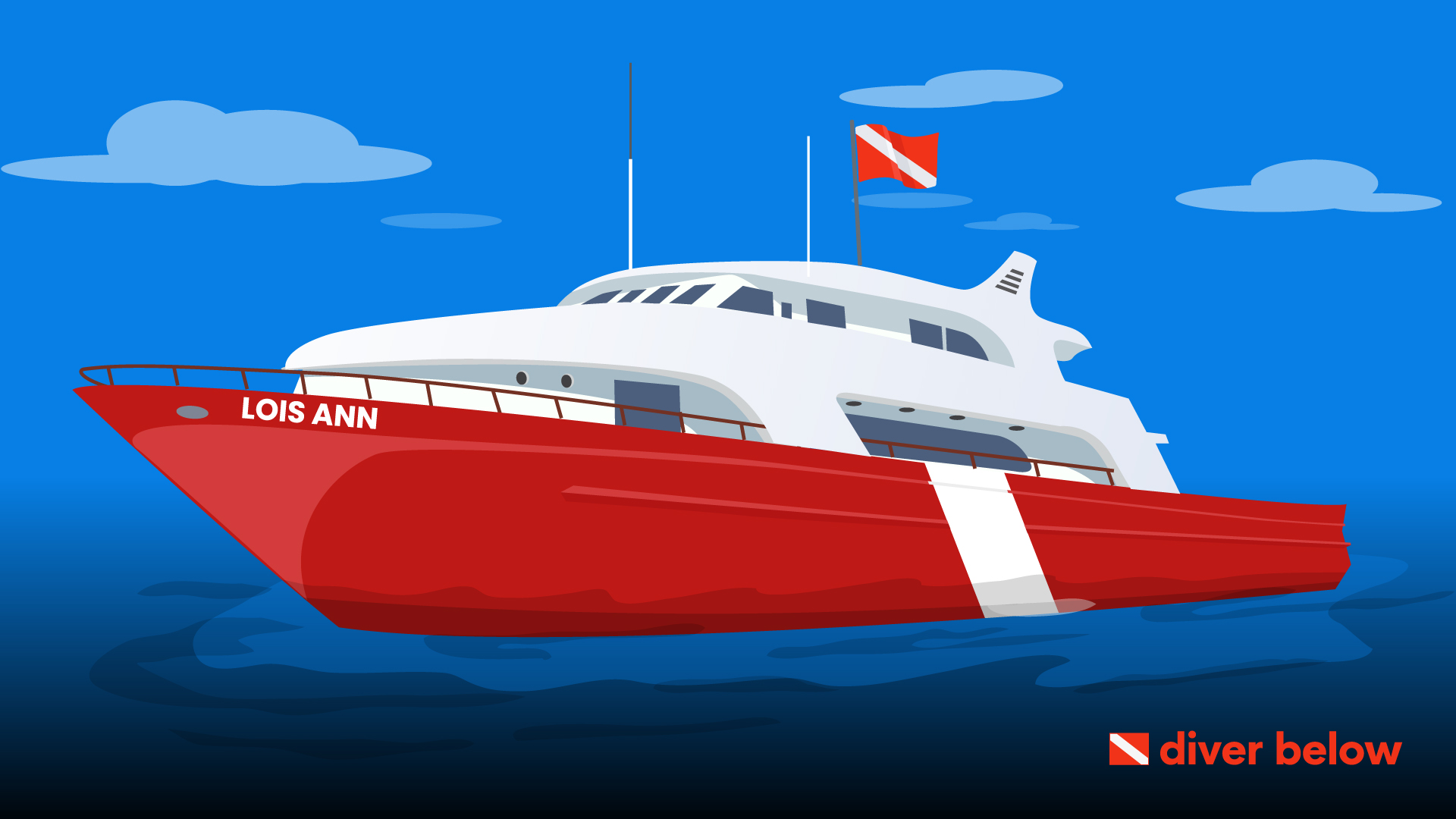
Cozumel
Located in Mexico, Cozumel is a Caribbean paradise and year-round scuba diving destination.
The sea sponges are vibrant, the water incredibly clear, and the assortment of marine life is wonderful to behold.
You can always see sharks, turtles, and rays, but the island has so much more to offer.
There are also plenty of instructors around to help!
Check out a dive resort today to have the time of your life swimming underwater.
Bora Bora
Bora Bora is an exotic place to go scuba diving, located in beautiful French Polynesia.
This volcanic island attracts scuba divers from all around to go to Bora Bora just for the one-of-a-kind experience in their unique underwater seascape.
Bora Bora, surrounded by a gorgeous crystal blue lagoon and a beautiful barrier reef, is stunning.
See sharks, manta rays, colorful corals, and best of all, the topography undersea.
The water visibility and serene waves make Bora Bora perfect for new divers.
Visit:
- Anau
- Toopua
- Haapiti
- Tupitipiti
- Miri Miri
Florida
Find sea turtles, sailfish, whales, turtles, and all kinds of tropical fish when navigating through the Floridian waters.
Lemon sharks are a popular sighting during the summer, where the water is shallower close to the reef.
Advanced divers can experience the caverns that get as deep as 50 feet.
Check out the Molasses Reef that has caves, spur-and-groove formations, boulders, rays, turtles, and lobsters.
Australia
The Great Barrier Reef is one of the most popular locations to go scuba diving.
The possibilities are endless as the beautiful landscape and seascape have shipwrecks, diverse aquatic life, and giant kelp forests.
Divers will find turtles, white tip sharks, whale sharks, and many fish swimming about in this part of Australia.
Costa Rica
Costa Rica is a beautiful country that features beautiful blue oceans all around.
The manta rays and shark encounters are invigorating for divers, and the waters are fitting for divers at any level.
There is also a biological reserve in the southern region.
You’ll see a lot of pinnacles and boulders.
The coral reefs are also the perfect site to have your first scuba diving experience.
The rich beauty of Costa Rica is spectacular to behold from aboveground; imagine underwater!
Frequently Asked Questions
Here are the responses to a few of the most commonly asked questions regarding scuba diving:
1. Why do scuba divers roll backwards?
Divers dive backward to prevent the boat from rocking excessively.
If they dive in any other position, not only will the boat rock, causing other divers to fall in, but they could damage their scuba gear in the process.
2. Are scuba tanks pure oxygen?
While there are certain situations where dangerous environments call for pure oxygen, in general, compressed air is in scuba tanks.
The air consists of around 21 percent oxygen and a mixture of other breathing gases.
Pure oxygen inhaled for too long carries the risk of Central Nervous System oxygen toxicity.
3. Can scuba diving cause vertigo?
Vertigo is when you start feeling a little dizzy and nauseated because of pressure imbalances in a diver’s ears.
This feeling can occur on the descent, but it usually kicks in on the ascent, causing disorientation.
Wrapping Up
Scuba diving is a popular adventurous water activity and opens up a world of possibilities for experiencing the ocean.
Few sports can offer the kind of freedom and surreal voyages that scuba diving can.
If all of the precautions are taken to ensure the safety of you and your buddy, grab your gear and dive in!
